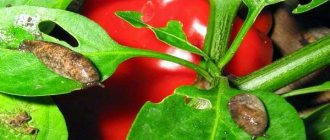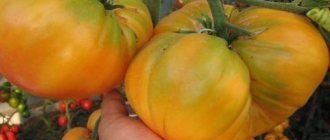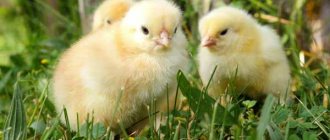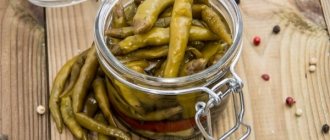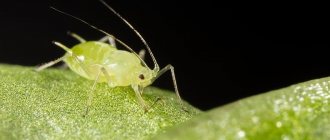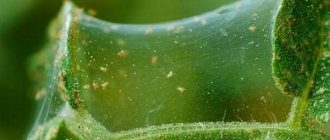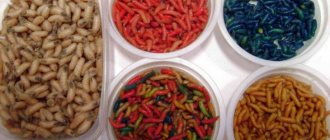What type of pepper is this?
Kubyshka pepper enjoys stable popularity among gardeners . A fruitful and versatile variety with large and tasty fruits, it does not require much attention in care. Peppers are stored for a long time and are rich in vitamins than many other varieties.
Characteristics and description of the variety
Capsicum is an unpretentious pepper, resistant to cold snaps , so it grows well both in a greenhouse and in open ground. The variety is early ripening, ripens 120 days after the appearance of the first shoots. The bush is spreading, reaching 100–120 cm in height.
Distinctive features
The peculiarity of this variety is that the fruits contain more vitamins and microelements than other varieties. This pepper is especially rich in beta-carotene and vitamin C.
And if you consider that it grows well even in the northern regions and in mountainous areas, everything together makes this variety a real boon for gardeners.
Other varieties of large-fruited peppers:
Bulgarian pepper “Merchant”: advantages and disadvantages of the variety
Bright and tasty sweet pepper “Golden Miracle”
Pepper “Pinocchio” for lovers of high-yielding varieties
Fruit characteristics, yield
The fruits of the Capsule are large and directed downwards . They have a cylindrical shape, slightly dome-shaped, wide, almost square, which is why they got their name.
By the period of full maturity, the fruit turns dark red and acquires a smooth shiny skin. Average weight – 250–300 g.
The pulp is juicy, 10 mm thick and more . Proper care allows you to collect from 1 square. m up to 6 kg of excellent fruits.
Advantages and disadvantages
Gardeners select a variety for planting due to the following positive characteristics:
- Capsicum pepper is immune to worsening weather conditions.
- The crop yield is at the level of the latest hybrids – from 6 kg/m2.
- The vegetable has time to ripen before the onset of steady cold weather.
- The fruits are attractive due to their taste.
- Pepper does not spoil during transportation.
- The vegetable is suitable for many types of culinary processing.
Among the negative properties of the variety, the following are noted:
- the plant is sensitive to nightshade diseases;
- The pepper needs to be shaped and tied.
Preparation for cultivation
Sowing seeds for seedlings is planned 60–70 days before planting in the ground . Before soaking, it is recommended to treat the seeds with a solution of mineral substances or a weak solution of potassium permanganate.
Then place in a damp cloth so that the seeds are not completely immersed in water, cover with a bag or film. Periodically check the moisture content of the fabric and add water if necessary. Comfortable temperature for seed germination is 26–28 °C. The film or bag is removed on the third day of seed germination so that excess moisture does not lead to plant disease.
The soil also requires preliminary preparation . You can use either a ready-made store-bought mixture or one you make yourself. Mix turf soil with vermicompost, compost, mineral fertilizers, and add ash. To prevent diseases and infections, it is recommended to freeze the soil or heat it in the oven.
Growing seedlings
When the seeds germinate, they are planted in seedling boxes, laid at a distance of 3-4 cm and sprinkled on top by no more than 10 mm . Then the boxes are covered with film again, creating a greenhouse effect so that the seedlings germinate at a comfortable temperature of 23–25 ° C.
Important! If the seedling boxes are not being used for the first time, it is recommended to treat them with a weak solution of potassium permanganate for disinfection.
When the first couple of leaves appear , it is time to transplant the plants into separate containers. To do this, their stems are taken with a lump of earth and placed in new soil. Be sure to water the pepper, but do it carefully: Capsule does not like excess water.
Before planting on the site, grown bushes must be hardened off so that they do not freeze when the temperature drops sharply. To do this, it is recommended to take them out into the fresh air or onto the veranda, protecting them from direct sunlight.
Some gardeners practice growing seedlings without picking , which also gives good results. The root system of Kubushka is weak, so after picking the plant experiences stress. This can slow down the growth of the bush and affect the yield.
Growing peppers from A to Z / Pepper seedlings / Growing peppers in open ground
Planting pepper
After 60–70 days, when there is no longer any threat of frost, the seedlings are planted in the ground on the site. It is recommended to place it on 1 sq. m no more than 4–6 plants - the Kubyshka bushes are quite spreading. It is necessary to plant without deepening the root collar, at the same level at which the pepper grew in boxes.
Important! If possible, plant peppers in the evening, in good weather. In the first days on the ground, you can cover the seedlings, because the Capsule does not like direct sunlight.
Remember that peppers will grow well where cucumbers, cabbage or peas were grown last season. And, on the contrary, it will give a poor harvest when planted after nightshades: tomatoes, potatoes, peppers.
Attention! Pepper of the Kubyshka variety, when transplanted into a greenhouse or open ground, experiences stress and stops growth. But don’t panic, this is a temporary phenomenon; later growth continues at the same pace.
Further care
Caring for the eggplant is quite simple : timely watering and fertilizing. Water the plant in the evening, as the soil dries, and apply mineral and organic fertilizers 2-3 times during growth.
From time to time, peppers need to be weeded, the soil loosened and the grown and heavy stems tied to supports.
To protect the roots of sweet peppers from drying out, you can mulch the soil with grass or any suitable material.
If a vegetable grows in a greenhouse, it is important not to forget to ventilate it, otherwise excess moisture will cause plant diseases.
2018 is the beginning! One, Hannibal and Orange Beauty
I sown seedlings on February 20-23, and planted them in open ground in early June.
- The only thing was that the fruits were in small capsules, mated well, were large, but not a single one began to ripen on the bush.
- Hannibal - the fruits should also have been cube-shaped, but chocolate-colored. They grew elongated with a sharp nose, the bushes began to darken, and chocolate stripes appeared. I rather took it off, I thought I’d ripen it at home so that the remaining ones on the bushes would grow up. But I didn’t know how to ripen then, the houses withered and nothing else had time to ripen on the bushes. Another failure.
- The orange beauty pleased everyone that year. There are many, large fruits. 1-2 peppers per bush ripened in open ground. It was not a victory, but a hint! It’s like in hockey: ours are losing to Canada 4:0, and then suddenly there’s a goal – 4:1! Not yet victory, but already joy.
Now I already know:
How to ripen sweet peppers at home so that they do not wilt, but remain juicy and beautiful
Features of growing the variety and possible difficulties
There are several subtleties that need to be taken into account when growing Egg Capsule; compliance with them will allow you to get a rich harvest :
- To get a lot of fruits from the bushes, you need to work on their formation. When the stem length reaches 20 cm, excess shoots are removed from the pepper, leaving only the two largest ones. Do the same when the new stem continues to bifurcate.
- It was mentioned above that the variety does not like replanting, so this must be done especially carefully and carefully.
- You cannot keep a technically ripe fruit on the branch for too long. Until the peppers are harvested, there will be no rapid growth of new flowers, and the next batch of crops will not have time to grow.
Description of the variety
The pepper bush “Kubishka” is spreading, tall – up to 1.2 m. The leaves are slightly wrinkled, dark green, medium in size. The fruits on the bushes ripen gradually and have an attractive appearance:
- fruit weight 230-250g;
- cylindrical shape, elongated, almost square in cross-section;
- wall thickness is average;
- ripened fruits acquire a bright red color;
- ripe peppers have a pleasant aroma and taste;
- used fresh, in the preparation of various dishes, for preservation;
- average yield 6 kg per 1 sq.m.
Typical diseases and pests
Like other sweet peppers, Kubyshka can be susceptible to diseases typical for them .
Most often these are fungal diseases such as phytoplasmosis and verticillium. For prevention, means such as “Barrier” and “Barrier” are used.
Stolbur is dangerous for peppers : the foliage and trunk turn yellow, the bush forms small fruits. This disease is carried by insects, so the best prevention is frequent weeding and loosening of the soil.
Sometimes white and gray rot forms . Control measures are as follows: diseased fruits are picked, and healthy ones are watered with a solution of saltpeter. Spraying pepper bushes with fungicides will help prevent these diseases.
Also, the eggplant can be attacked by various pests: the Colorado potato beetle, aphids, spider mites, and slugs. To combat them, insecticides, biological preparations and traditional methods are used.
For example, making grooves near the plant and sprinkling them with dry mustard helps get rid of slugs.
Pests of bell peppers and methods of controlling them
Like any other crop, bell pepper suffers from pests. Let's look at the most common of them:
- The Colorado potato beetle is the most dangerous enemy of vegetables. To get rid of it, an infusion of celandine is sprayed on the bushes, and the pests are also collected manually.
- Naked slugs cause enormous damage to the plant. To prevent their occurrence, parsley is planted between the rows of peppers. If slugs appear, sprinkle the pepper bushes with dry mustard and collect the slugs by hand.
- Spider mites will go away if you spray the pepper bushes with a solution of onion juice, chopped garlic and liquid soap.
- Aphids are the most common pest of peppers. You can get rid of it with the help of insecticides.
Reviews
The variety gained popularity and became quite widespread . Judging by the reviews of gardeners who are already growing it, pepper is excellent for winter harvesting.
Elena, Volgograd : “The Kubyshka pepper never ceases to please me; I’ve been planting it for three seasons now. The harvest is always rich, the fruits are even and beautiful, just like in a picture. Grows up to 400 grams. And the taste is excellent: we eat it well both in lecho and in salads. I also like that it begins to ripen within a month after the seedlings are planted.”
Angelina, Pskov : “I really liked the Kubyshka variety, I even surprised it. The fruits are so large that they cannot fit in the palm of your hand, they are fleshy and juicy. The best thing for treatment: I made preparations for the whole winter. True, it should be noted: this pepper has such large and wide bushes that they definitely need to be tied up.”
Olga, Voronezh : “I was specifically looking for a variety that can be grown in open ground and not in a greenhouse. I decided to try Kubyshka. And I’m very glad that I made the right decision: the taste is excellent, and there were no special worries with it. The transplant went well, the fruits set and turned red almost simultaneously, there were no diseases, not even black leg, from which all my peppers usually suffered. I will definitely plant this variety again next season.”
Plant care
Capsicum pepper is an unpretentious plant, but, like all peppers, it prefers warm habitats and feels better in ridges and greenhouses sheltered from the wind.
After planting seedlings in a permanent place, the plants adapt for quite a long time; during this period they only need periodic watering (depending on the weather 1-2 times a week), and after 1-2 weeks they can begin to be fed.
The first fertilizers, liquid - herbal infusion or mullein solution, diluted 1:10, are applied on damp soil - after watering.
When the peppers grow to 15-20 cm, their tops can be pinched for more active branching of the stem. It is advisable to remove all stepsons that grow to the fork of the stem in a timely manner. When forming a plant, it is considered optimal to have 2-3 main stems.
